ch8 数据库系统概念(第6版)第八章关系数据库设计
- 格式:pdf
- 大小:1.51 MB
- 文档页数:62



数据库系统概念第六版课程设计一、选题背景随着信息技术的发展,数据的数量和类型变得越来越复杂和庞大,需要有效地管理和处理。
数据库系统作为数据管理的关键技术之一,应用广泛。
通过学习数据库系统的概念、原理和实现方法,可以帮助学生深入理解数据管理、数据结构和数据操作等基本概念,并掌握常用数据库系统的设计和开发方法。
本课程设计旨在通过对数据库系统概念第六版的学习和实践,帮助学生全面了解数据库系统的基础知识,提高数据管理和处理能力。
二、选题内容本课程设计主要包括以下几个部分:1.数据库设计与实现:根据给出的实际场景,设计一个关系型数据库,并使用MySQL实现。
包括数据模型设计、表结构设计、数据类型定义、SQL语句编写等内容。
2.数据库应用开发:基于Java语言和JDBC技术,开发一个简单的图书管理系统,实现图书的查询、添加、修改和删除等功能。
包括前端UI设计、后端业务逻辑实现和数据库操作等内容。
3.数据库性能调优:分析数据库在不同负载条件下的性能表现,设计和实施调优策略。
包括SQL语句优化、索引优化、缓存策略、服务器参数优化等内容。
4.数据库备份与恢复:制定数据库备份和恢复策略,实现对数据库的定时备份和快速恢复。
包括备份方案设计、恢复操作测试、恢复时间评估等内容。
三、选题目的通过此次课程设计,旨在达到以下目标:1.学生能够全面了解数据库系统的原理、架构和应用场景,掌握常用的关系型数据库系统的设计和开发方法。
2.学生能够运用Java语言和JDBC技术,开发一个简单的图书管理系统,掌握前后端交互和数据库操作等基本技能。
3.学生能够分析数据库在不同负载条件下的性能表现,能够设计和实施调优策略,提高数据库系统的运行效率。
4.学生能够制定数据库备份和恢复策略,实现对数据库的高效备份和快速恢复,提高数据安全性和可靠性。
四、选题材料本课程设计所需的主要材料包括:1.《数据库系统概念第六版》一书作为课程教材。
2.Java语言和JDBC技术相关的书籍和资料,如《Java核心技术》、《Java编程思想》等。
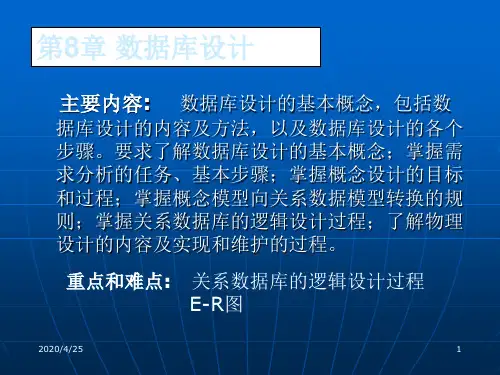
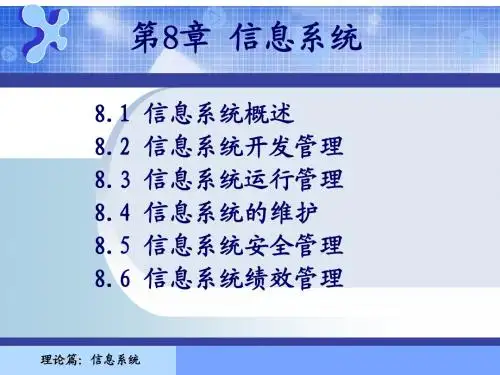
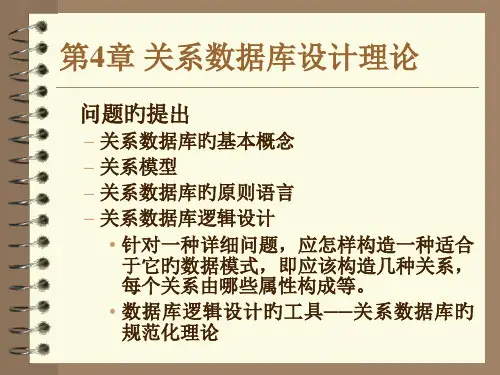
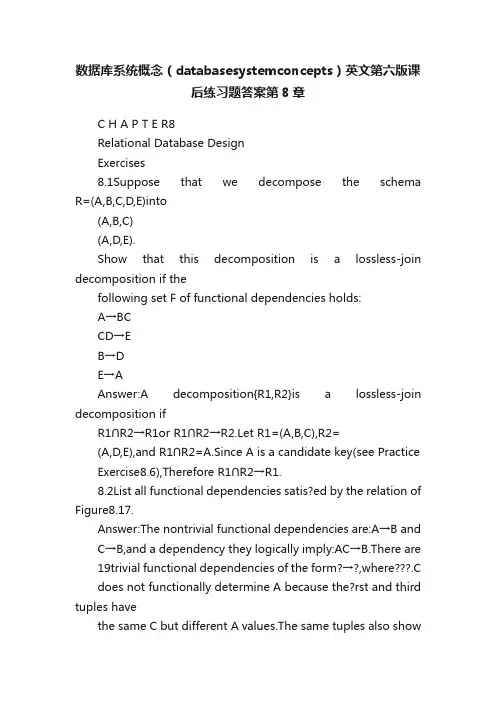
数据库系统概念(databasesystemconcepts)英文第六版课后练习题答案第8章C H A P T E R8Relational Database DesignExercises8.1Suppose that we decompose the schema R=(A,B,C,D,E)into(A,B,C)(A,D,E).Show that this decomposition is a lossless-join decomposition if thefollowing set F of functional dependencies holds:A→BCCD→EB→DE→AAnswer:A decomposition{R1,R2}is a lossless-join decomposition ifR1∩R2→R1or R1∩R2→R2.Let R1=(A,B,C),R2=(A,D,E),and R1∩R2=A.Since A is a candidate key(see Practice Exercise8.6),Therefore R1∩R2→R1.8.2List all functional dependencies satis?ed by the relation of Figure8.17.Answer:The nontrivial functional dependencies are:A→B and C→B,and a dependency they logically imply:AC→B.There are 19trivial functional dependencies of the form?→?,where.C does not functionally determine A because the?rst and third tuples havethe same C but different A values.The same tuples also showB does notfunctionally determine A.Likewise,A does not functionally determineC because the?rst two tuples have the same A value and different Cvalues.The same tuples also show B does not functionally determine C.8.3Explain how functional dependencies can be used to indicate the fol-lowing:910Chapter8Relational Database DesignA one-to-one relationship set exists between entity sets student andinstructor.A many-to-one relationship set exists between entity sets studentand instructor.Answer:Let Pk(r)denote the primary key attribute of relation r.The functi onal dependencies Pk(student)→Pk(instructor)and Pk(instructor)→Pk(student)indicate a one-to-one relationshipbecause any two tuples with the same value for student must havethe same value for instructor,and any two tuples agreeing on instructor must have the same value for student.The functional dependency Pk(student)→Pk(instructor)indicates amany-to-one relationship since any student value which isrepeatedwill have the same instructor value,but many student values mayhave the same instructor value.8.4Use Armstrong’s axioms to prove the soundness of the union rule.(Hint:Use the augmentation rule to show that,if?→?,then?→??.Apply theaugmentation rule again,using?→?,and then apply the transitivityrule.)Answer:To prove that:if?→?and?→?then?→??Following the hint,we derive:→?given→??augmentation rule→??union of identical sets→?given→??augmentation rule→??transitivity rule and set union commutativity8.5Use Armstrong’s axioms to prove the soundness of the pseudotransitiv-ity rule.Answer:Pr oof using Armstrong’s axioms of the Pseudotransitivity Rule:if?→?and??→?,then??→?.→?given→??augmentation rule and set union commutativity→?given→?transitivity rule8.6Compute the closure of the following set F of functional dependenciesfor relation schema R=(A,B,C,D,E).Exercises 11A →BCCD →EB →DE →AList the candidate keys for R .Answer:Note:It is not reasonable to expect students to enumerate all of F +.Some shorthand representation of the result should be acceptable as long as the nontrivial members of F +are found.Starting with A →BC ,we can conclude:A →B and A →C .Since A →B and B →D ,A →D (decomposition,transitive)Since A →C D and C D →E ,A →E (union,decom-position,transi-tive)Since A →A ,we have (re?exive)A →ABC DE from the above steps (union)Since E →A ,E →ABC DE (transitive)Since C D →E ,C D →ABC DE (transitive)Since B →D and BC →C D ,BC →ABC DE (augmentative,transitive)Also,C →C ,D →D ,B D →D ,etc.Therefore,any functional dependency with A ,E ,BC ,or C D on the left hand side of the arrow is in F +,no matter which other attributes appear in the FD.Allow *to represent any set of attributes in R ,then F +is B D →B ,B D →D ,C →C ,D →D ,B D →B D ,B →D ,B →B ,B →B D ,and all FDs of the form A ?→?,BC ?→?,C D ?→?,E ?→?where ?is any subset of {A ,B ,C ,D ,E }.The candidate keys are A ,BC ,C D ,and E .8.7Using the functional dependencies of Practice Exercise8.6,compute thecanonical cover F c .Answer:The given set of FDs F is:-A →BCCD →EB →DE →AThe left side of each FD in F is unique.Also none of the attributes in the left side or right side of any of the FDs is extraneous.Therefore the canonical cover F c is equal to F .12Chapter8Relational Database Design8.8Consider the algorithm in Figure8.18to compute?+.Show that thisalgorithm is more ef?cient than the one presented in Figure8.8(Sec-tion8.4.2)and that it computes?+correctly.Answer:The algorithm is correct because:If A is added to result then there is a proof that?→A.T o see this,observe that?→?trivially so?is correctly part of result.IfA∈?is added to result there must be some FD?→?such that A∈?and?is already a subset of result.(Otherwise f dcountwould be nonzero and the if condition would be false.)A full proofcan be given by induction on the depth of recursion for an executionof addin,but such a proof can be expected only from students witha good mathematical background.If A∈?+,then A is eventually added to result.We prove this byinduction on the length of the proof of?→A using Armstrong’saxioms.First observe that if procedure addin is called with someargument?,all the attributes in?will be added to result.Also if aparticular FD’s fdcount becomes0,all the attributes in its tail willde?nitely be added to result.The base case of the proof,A∈??A∈?+,is obviously true b ecause the?rst call to addinhas the argument?.The inductive hypotheses is that if?→A canbe proved in n steps or less then A∈result.If there is a proof inn+1steps that?→A,then the last step was an application ofeither re?exivity,augmentation or transiti vity on a fact?→?proved in n or fewer steps.If re?exivity or augmentation was usedin the(n+1)st step,A must have been in result by the end of the n thstep itself.Otherwise,by the inductive hypothesis??result.Therefore the dependency used in proving?→?,A∈?willhave f dcount set to0by the end of the n th step.Hence A will beadded to result.To see that this algorithm is more ef?cient than the one presented inthe chapter note that we scan each FD once in the main program.Theresulting array a ppears has size proportional to the size ofthe givenFDs.The recursive calls to addin result in processing linear in the sizeof a ppears.Hence the algorithm has time complexity which is linear inthe size of the given FDs.On the other hand,the algorithm given in thetext has quadratic time complexity,as it may perform the loop as manytimes as the number of FDs,in each loop scanning all of them once.8.9Given the database schema R(a,b,c),and a relation r on the schema R,write an SQL query to test whether the functional dependency b→cholds on relation r.Also write an SQL assertion that enforces the func-tional dependency.Assume that no null values are present.(Althoughpart of the SQL standard,such assertions are not supported by anydatabase implementation currently.)Answer:Exercises13a.The query is given below.Its result is non-empty if and only ifb→c does not hold on r.select bfrom rgroup by bhaving count(distinct c)>1b.create assertion b to c check(not exists(select bfrom rgroup by bhaving count(distinct c)>1))8.10Our discussion of lossless-join decomposition implicitly assumed thatattributes on the left-hand side of a functional dependency cannot take on null values.What could go wrong on decomposition,if this property is violated?Answer:The natural join operator is de?ned in terms of the cartesian product and the selection operator.The selection operator,gives unknown for any query on a null value.Thus,the natural join excludes all tuples with null values on the common attributes from the?nal result.Thus, the decomposition would be lossy(in a manner different from the usual case of lossy decomposition),if null values occur in the left-hand side of the functional dependency used to decompose the relation.(Null values in attributes that occur only in the right-hand side of the functional dependency do not cause any problems.)8.11In the BCNF decomposition algorithm,suppose you usea functional de-pendency?→?to decompose a relation schema r(?,?,?)into r1(?,?) and r2(?,?).a.What primary and foreign-key constraint do you expect toholdon the decomposed relations?b.Give an example of an inconsistency that can arise due to anerroneous update,if the foreign-key constraint were not enforcedon the decomposed relations above.c.When a relation is decomposed into3NF using the algorithm inSection8.5.2,what primary and foreign key dependencies wouldyou expect will hold on the decomposed schema?14Chapter8Relational Database DesignAnswer:a.?should be a primary key for r1,and?should be the foreign keyfrom r2,referencing r1.b.If the foreign key constraint is not enforced,then a deletion of atuple from r1would not have a corresponding deletion from thereferencing tuples in r2.Instead of deleting a tuple from r,this would amount to simply setting the value of?to null in some tuples.c.For every schema r i(??)added to the schema because of a rule→?,?should be made the primary key.Also,a candidate key?for the original relation is located in some newly created relationr k,and is a primary key for that relation.Foreign key constraints are created as follows:for each relationr i created above,if the primary key attributes of r i also occur inany other relation r j,then a foreign key constraint is created fromthose attributes in r j,referencing(the primary key of)r i.8.12Let R1,R2,...,R n be a decomposition of schema U.Let u(U)be a rela-(u).Show thattion,and let r i= RIu?r11r21···1r nAnswer:Consider some tuple t in u.(u)implies that t[R i]∈r i,1≤i≤n.Thus,Note that r i= Rit[R1]1t[R2]1...1t[R n]∈r11r21...1r nBy the de?nition of natural join,t[R1]1t[R2]1...1t[R n]= ?(??(t[R1]×t[R2]×...×t[R n]))where the condition?is satis?ed if values of attributes with the samename in a tuple are equal and where?=U.The cartesian productof single tuples generates one tuple.The selection process is satis?edbecause all attributes with the same name must have the same valuesince they are projections from the same tuple.Finally,the projectionclause removes duplicate attribute names.By th e de?nition of decomposition,U=R1∪R2∪...∪R n,which meansthat all attributes of t are in t[R1]1t[R2]1...1t[R n].That is,t is equalto the result of this join.Since t is any arbitrary tuple in u,u?r11r21...1r n8.13Show that the decomposition in Practice Exercise8.1is not a dependency-preserving decomposition.Answer:The dependency B→D is not preserved.F1,the restrictionof F to(A,B,C)is A→ABC,A→AB,A→AC,A→BC,Exercises 15A →B ,A →C ,A →A ,B →B ,C →C ,AB →AC ,AB →ABC ,AB →BC ,AB →AB ,AB →A ,AB →B ,AB →C,AC (same as AB ),BC (same as AB ),ABC (same as AB ).F 2,the restriction of F to (C ,D ,E )is A →ADE ,A →AD ,A →AE ,A →DE ,A →A ,A →D ,A →E ,D →D ,E (same as A ),AD ,AE ,DE ,ADE (same as A ).(F 1∪F 2)+is easily seen not to contain B →D since the only F D in F 1∪F 2with B as the left side is B →B ,a trivial FD .We shall see in Practice Exercise 8.15that B →D is indeed in F +.Thus B →D is not preserved.Note that C D →ABC DE is also not preserved.A simpler argument is as follows:F 1contains no dependencies with D on the right side of the arrow.F 2contains no dependencies withB on the left side of the arrow.Therefore for B →D to be preserved theremustbe an FD B →?in F +1and ?→D in F +2(so B →D would follow by transitivity).Since the intersection of the two schemes isA ,?=A .Observe thatB →A is not in F +1since B +=B D .8.14Show that it is possible to ensure that a dependency-preserving decom-position into 3NF is a lossless-join decomposition by guaranteeing that at least one schema contains a candidate key for the schema being decom-posed.(Hint :Show that the join of all the projections onto the schemas of the decomposition cannot have more tuples than the original relation.)Answer:Let F be a set of functional dependencies that hold on a schema R .Let ?={R 1,R 2,...,R n }be a dependency-preserving 3NF decompo-sition of R .Let X be a candidate key for R .Consider a legal instance r of R .Let j = X (r )1 R 1(r )1 R 2(r ) (1)R n (r ).We want to prove that r =j .We claim that if t 1and t 2are two tuples in j such that t 1[X ]=t2[X ],then t 1=t 2.To prove this claim,we use the following inductive argument –Let F ′=F 1∪F 2∪...∪F n ,where each F i is the restriction of F to the schema R i in ?.Consider the use of the algorithm given in Figure 8.8to compute the closure of X under F ′.We use induction on the number of times that the f or loop in this algorithm is executed.Basis :In the ?rst step of the algorithm,result is assigned to X ,and hence given that t 1[X ]=t 2[X ],we know that t 1[result ]=t 2[result ]is true.?Induction Step :Let t 1[result ]=t 2[result ]be true at the end of thek th execution of the f or loop.Suppose the functionaldependency considered in the k +1th execution of the f or loop is ?→?,and that ??result .??result implies that t 1[?]=t 2[?]is true.The facts that ?→?holds for some attribute set Ri in ?,and that t 1[R i ]and t 2[R i ]are inR i (r )imply that t 1[?]=t 2[?]is also true.Since ?is now added to result by the algorithm,we know that t 1[result ]=t 2[result ]is true at theend of the k +1th execution of the f or loop.16Chapter8Relational Database DesignSince?is dependency-preserving and X is a key for R,all attributes in Rare in result when the algorithm terminates.Thus,t1[R]=t2[R]is true,that is,t1=t2–as claimed earlier.Our claim implies that the size of X(j)is equal to the size of j.Notealso that X(j)= X(r)=r(since X is a key for R).Thus we haveproved that the size of j equals that of /doc/826273026.htmling the result of PracticeExercise8.12,we know that r?j.Hence we conclude that r=j.Note that since X is trivially in3NF,?∪{X}is a dependency-preservinglossless-join decomposition into3NF.8.15Give an example of a relation schema R′and set F′of functional depen-dencies such that there are at least three distinct lossless-join decompo-sitions of R′into BCNF.Answer:Given the relation R′=(A,B,C,D)the set of functionaldependencies F′=A→B,C→D,B→C allows three distinctBCNF decompositions.R1={(A,B),(C,D),(B,C)}is in BCNF as isR2={(A,B),(C,D),(A,C)}R2={(A,B),(C,D),(A,C)}R3={(B,C),(A,D),(A,B)}8.16Let a prime attribute be one that appears in at least one candidate key.Let?and?be sets of attributes such that?→?holds,but?→?does not hold.Let A be an attribute that is not in?,is not in?,and forwhich?→A holds.We say that A is transitively dependent on?.Wecan restate our de?nition of3NF as follows:A relation schema R is in3NF with respect to a set F of functional dependencies if there are nononprime attributes A in R for which A is transitively dependent on akey for R.Show that this new de?nition is equivalent to the original one.Answer:Suppose R is in3NF according to the textbook de?nition.Weshow that it is in3NF according to the de?nition in the exercise.Let A bea nonprime attribute in R that is transitively dependent on a key?forR.Then there exists??R such that?→A,?→?,A∈?,A∈,and?→?does not hold.But then?→A violates the textbookde?nition of3NF sinceA∈?implies?→A is nontrivialSince?→?does not hold,?is not a superkeyA is not any candidate key,since A is nonprimeExercises17 Now we show that if R is in3NF according to the exercise de?nition,it is in3NF according to the textbook de?nition.Suppose R is not in3NF according the the textbook de?nition.Then there is an FD?→?that fails all three conditions.Thus→?is nontrivial.is not a superkey for R.Some A inis not in any candidate key.This implies that A is nonprime and?→A.Let?be a candidate key for R.Then?→?,?→?does not hold(since?is not a superkey), A∈?,and A∈?(since A is nonprime).Thus A is transitively dependent on?,violating the exercise de?nition.8.17A functional dependency?→?is called a partial dependency if thereis a proper subset?of?such that?→?.We say that?is partially dependent on?.A relation schema R is in second normal form(2NF)if each attribute A in R meets one of the following criteria:It appears in a candidate key.It is not partially dependent on a candidate key.Show that every3NF schema is in2NF.(Hint:Show that every partial dependency is a transitive dependency.)Answer:Referring to the de?nitions in Practice Exercise8.16,a relation schema R is said to be in3NF if there is no non-prime attribute A in R for which A is transitively dependent on a key forR.We can also rewrite the de?nition of2NF given here as:“A relation schema R is in2NF if no non-prime attribute A is partially dependent on any candidate key for R.”To prove that every3NF schema is in2NF,it suf?ces to show that if a non-prime attribute A is partially dependent on a candidate key?,thenA is also transitively dependent on the key?.Let A be a non-prime attribute in R.Let?be a candidate key for R.Suppose A is partially dependent on?.From the de?nition of a partial dependency,we know that for someproper subset?of?,?→A.Since,?→?.Also,?→?does not hold,sin ce?is acandidate key.Finally,since A is non-prime,it cannot be in either?or?.Thus we conclude that?→A is a transitive dependency.Hence we have proved that every3NF schema is also in2NF.8.18Give an example of a relation schema R and a set of dependencies suchthat R is in BCNF but is not in4NF.18Chapter8Relational Database DesignAnswer:R(A,B,C)A→→BExercises19result:=?;/*fdcount is an array whose i th element contains the number of attributes on the left side of the i th FD that arenot yet known to be in?+*/for i:=1to|F|dobeginlet?→?denote the i th FD;fdcount[i]:=|?|;end/*appears is an array with one entry for each attribute.The entry for attribute A is a list of integers.Each integeri on the list indicates that A appears on the left sideof the i th FD*/for each attribute A dobeginappears[A]:=NI L;for i:=1to|F|dobeginlet?→?denote the i th FD;if A∈?then add i to appears[A];endendaddin(?);return(result);procedure addin(?);for each attribute A in?dobeginif A∈result thenbeginresult:=result∪{A};for each element i of appears[A]dobeginfdcount[i]:=fdcount[i]?1;if fdcount[i]:=0thenbeginlet?→?denote the i th FD;addin(?);endendendendFigure8.18.An algorithm to compute?+.。
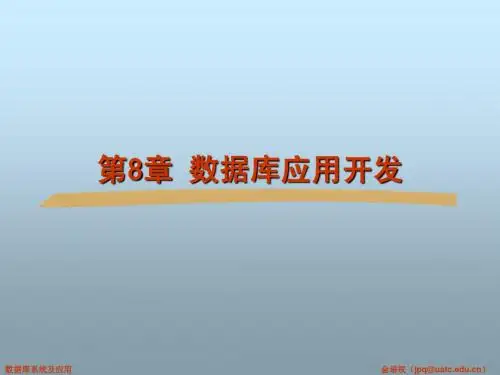
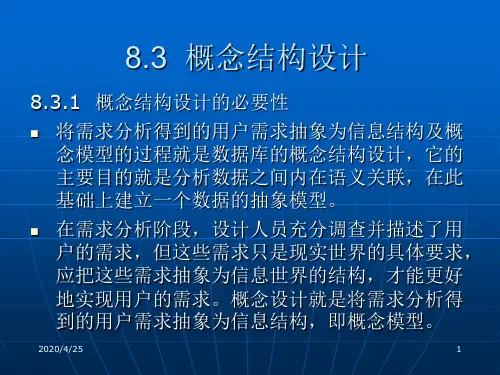


第六章关系数据理论第六章讲解关系数据理论。
这是关系数据库的又一个重点。
学习本章的目的有两个。
一个是理论方面的,本章用更加形式化的关系数据理论来描述和研究关系模型。
另一个是实践方面的,关系数据理论是我们进行数据库设计的有力工具。
因此,人们也把关系数据理论中的规范化理论称为数据库设计理论,有的书把它放在数据库设计部分介绍以强调它对数据库设计的指导作用。
一、基本知识点本章讲解关系数据理论,内容理论性较强,分为基本要求部分(《概论》6.1~6.3)和高级部分《概论》6.4)。
前者是计算机大学本科学生应该掌握的内容;后者是研究生应该学习掌握的内容。
①需要了解的:什么是一个“不好”的数据库模式;什么是模式的插入异常和删除异常;规范化理论的重要意义。
②需要牢固掌握的:关系的形式化定义;数据依赖的基本概念(函数依赖、平凡函数依赖、非平凡的函数依赖、部分函数依赖、完全函数依赖、传递函数依赖的概念,码、候选码、外码的概念和定义,多值依赖的概念);范式的概念;从lNF 到4NF的定义;规范化的含义和作用。
③需要举一反三的:四个范式的理解与应用,各个级别范式中存在的问题(插入异常、删除异常、数据冗余)和解决方法;能够根据应用语义,完整地写出关系模式的数据依赖集合,并能根据数据依赖分析某一个关系模式属于第几范式。
④难点:各个级别范式的关系及其证明。
二、习题解答和解析1.理解并给出下列术语的定义:函数依赖、部分函数依赖、完全函数依赖、传递依赖、候选码、主码、外码、全码(All-key)、lNF、2NF、3NF、BCNF、多值依赖、4NF。
解析解答本题不能仅仅把《概论》上的定义写下来。
关键是真正理解和运用这些概念。
答函数依赖:设R(U)是一个关系模式,U是R的属性集合,X和Y是U的子集。
对于R(U)的任意一个可能的关系r,如果r中不存在两个元组,它们在X上的属性值相同,而在Y上的属性值不同,则称“X函数确定Y”或“Y函数依赖于X”,记作X→Y。